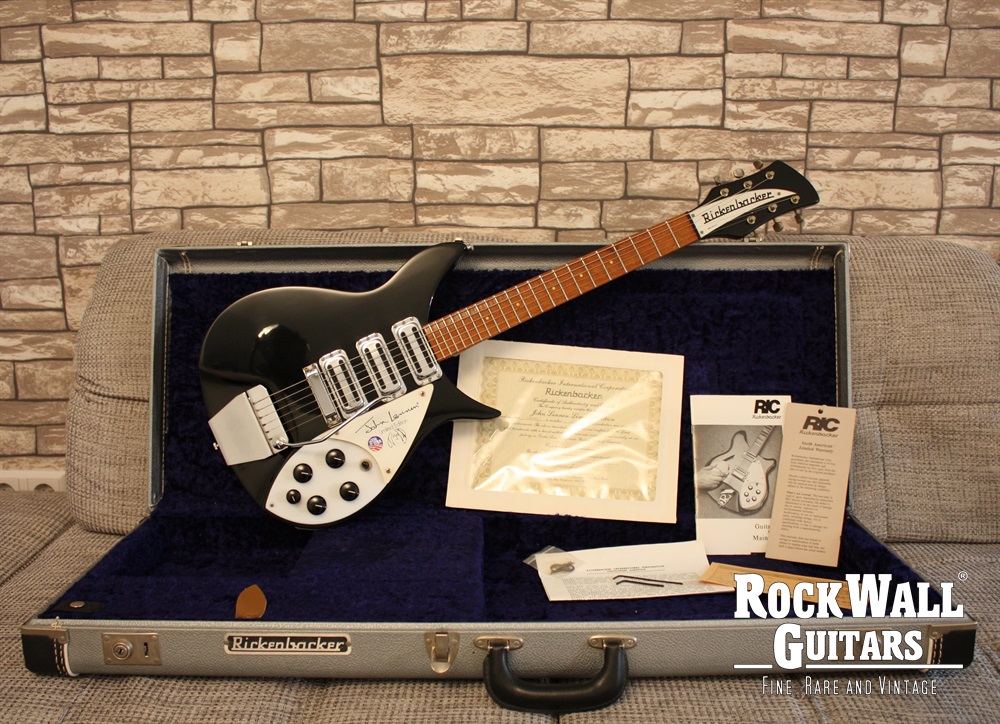

With everything centered, you get all three. ) Between the switch and the blend, you can get any possible combination of pickups. There are passive bass and treble controls, master volume, and a blend control for the middle pickup that lets you wipe it away because Lennon didn’t like the middle pickup and disconnected it ( or more likely, it broke. The pickups are Danelectro lipsticks, series-wired, the knobs are real Rickenbacker. The bridge is Rickenbacker-style and works surprisingly well, the cover gives you a place to rest your hand. Tuners are simple cheap covered models, with the covers removed for a nice open-gear look like you would have found back in the early 1960s. The scale is a modern 25.5, not the original, which was something like 22″ if I remember correctly. The side binding tape is the first time I used my own homemade stuff, and I glued it on with something that will hopefully be permanent because the standard contact cement sure isn’t. The neck uses a classic Danelectro dual steel A-frame truss rod, no adjustment necessary, with a Danelectro 3-in-line bolt-on attachment, and aluminum nut. I would not use poplar for a neck again, there is simply no reason not to use maple, it is superior in every way. The body construction is masonite over a hollow plywood core, while the neck is poplar, a la Danelectro.
#RICKENBACKER 325 JOHN LENNON INSTALL#
The neck is a full two octaves like the original, and I did install a full set of side markers, I’m not that slavish. The missing dot markers are authentic – Ric was too cheap to install a full set in the models they shipped to Europe. Patterned after JL’s Ric 325, after he painted it black. This was one of my earliest builds – a ‘John Lennon’ Danelectro 325. The little weird Ric knob is an active distortion circuit, the only remnant of the fully active electronics that I installed at first and then decided were wasted here and better used in a bass.

The tone controls are passive treble and bass, with a single master volume. Works great, and would probably be an awesome way to wire a bass. You can wash out the middle pickup, or the end pickups, or have any combination of all three.
#RICKENBACKER 325 JOHN LENNON SERIES#
The second upper knob is a series balance control between the switch output and the middle pickup. The switch selects between the neck and bridge pickups, in series. While poplar is true to the old Danelectro way, maple is superior and just as available, and I doubt I will ever make another poplar neck. This neck is a success, the result of what I learned from the first one which was not strong enough at the headstock. Poplar is easier to work than maple, but also softer and weaker. I hope all that poly doesn’t clog the pores and keep the plywood from breathing. New white edge binding, and it will be back to what it was before, except now in indestructible polyurethane instead of don’t-touch-me lacquer. The neck will get a thick over-coat of clear spray poly, and the body will get a thick coat of brush-on poly, then both will be sanded smooth and polished. I have already re-shot it in black poly/stain. Stripped – note the quality of the old-growth masonite. Acrylic lacquers are somewhat better, but nitro is just terrible. As yet I have not managed to get the same degree of high polish with poly as I have with lacquer, but I would much rather have an instrument that I am not afraid to touch. The body already has a base coat of black polyurethane. About the only good thing about lacquer is that when you realize what an awful mistake it is, you can get it off without too much trouble and refinish. So the other day I spent a can of acetone and a roll of paper towels and stripped the whole thing down to the wood. Prolonged contact with just about any surface leaves a mark. This guitar was finished in an absolutely gorgeous deep polished black nitrocellulose lacquer. If that music shop in Hamburg had had a Stratocaster on display, Rickenbacker would be a forgotten footnote in music history. The bass will use Ric string spacing, but that is not a problem like their guitars. In fact, I scrapped the first neck I built for this guitar (which is the one in this picture,) but not solely for that reason. My original setup for this one was standard Ric spacing, and I hated it.

Rics are beautiful pieces of art, but they are lousy guitars, not made for human hands. Every important dimension matches my Strat. He just loved the way it played and sounded, and completely missed all the obvious cues as to what it really is. I got a good laugh one day when I showed it to a local ‘pro’ who was so taken with it that he didn’t notice that it is not a real Ric, I had to point it out.

This guitar is built entirely in the spirit of wrongness. Rickenbacker 325 Guitar (2/3) The original flawed neck


 0 kommentar(er)
0 kommentar(er)
